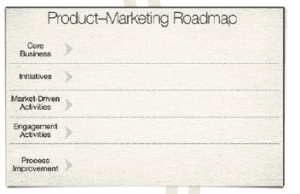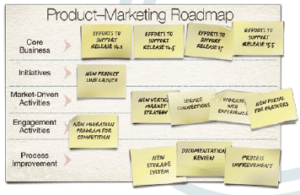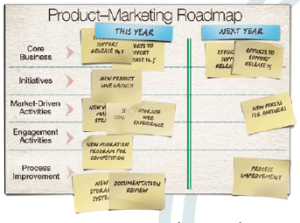11 minute read
A product marketing roadmap helps product marketers strategically plan, communicate and demonstrate their efforts to support a product’s success. This article shows you how you can build one.
Product roadmaps are crucial for setting direction, enhancing communication and reinforcing the focus of both the product and the company. Oftentimes, however, the technical direction for a product is all that is mapped out. Product roadmaps for the other efforts that go into the product planning lifecycle are often overlooked. This is a disservice to the product marketing team because they have the same need for strategic planning as do their counterparts in product management. They also need a document that lets them share their direction and improve communication and credibility.
Product marketing tends to be misunderstood, which may be where this oversight comes from. Product management is aligned with users and a product’s capabilities, product marketing is aligned with buyer’s and the product’s marketability. Executives tend to focus on data sheets and white papers but might not see the strategic value.
By building a product marketing roadmap, product marketers can show the critical work being done to support the product. This strategic planning process lays out the vision of when the work will be accomplished and it when overlaid with the product roadmap, it will create a more complete picture.
What is a product marketing roadmap?
The product-marketing roadmap shows executives, product management, development, marketing and other colleagues the go-to-market vision. It adds credibility to the product marketing team by demonstrating that its focus is set on continuous development, instead of reactive and one-off efforts.
It also allows the attention to shift from lead-generation campaigns to the more strategic analyzing of win/loss data, gaining customer insight, developing buyer personas, creating competitive SWOT analyses and similar activities. These types of activities increase your value, while also making your messaging in lead generation campaigns clearer, more targeted and easier to create.
Initial Steps in Creating a Product Marketing Roadmap
Taking the first step in building a product marketing roadmap can seem overwhelming. When you break it down into steps, however, it’s actually a fairly simple process.
Step 1: Obtain a copy of your product’s technical roadmap for the next eight quarters.
Two years is considered long enough to look at what is coming, while still offering flexibility to be responsive to shifting market dynamics. If your organization has a portfolio strategy and vision, connect with its owner and become familiar with it.
Step 2: Obtain your marketing team’s plans
You need to understand what the marketing team is doing and how they do it. What are their goals? What are their expectations? To do this you need to obtain their plans for demand generation, web, social media, events, papers, PR and anything else they may have planned. If possible, try to get their plans for the same two-year period.
Step 3: Obtain the goals and plans of ancillary marketing teams.
If you have teams focused on strategic planning for channel, alliance or partner relationships, find out their plans. Are they launching new programs in the next eight quarters? Their activities may be relevant, and it’s best to be informed.
Step 4: Arrange an all-day, off-site meeting for the product marketing team.
Being outside of the office can help minimize distractions and interruptions. You do not need an extravagant location, just a workspace and whiteboards will do. If possible, arrange for beverages, snacks and lunch. This is a small investment but can help keep everyone energized and enthusiastic about the strategic planning process.
Step 5: Arrange for a facilitator.
Find a facilitator that does not have a vested interest in the outcome. They can help to ensure that all ideas are listened to and that everyone is engaged in the process. Some companies that use agile processes have coaches, facilitators or trainers that could fill this role. If not, consider reaching out to local product groups and organizations.
Having enough prep time with the facilitator is the key to a successful meeting. Show them an example of a product marketing roadmap so they know what the end result should look like. Talk with them about how you would like to encourage participation and how to engage all team members. This can help prepare them to help facilitate a product meeting where everyone is fully committed to reaching the same end goal.
Step 6: Put the product marketing team in the room.
What you bring into the room is important, so bring in sticky notes, paper, whiteboards and copies of the roadmaps, plans and marketing artifacts (i.e. Sales sheets, etc.), but leave computers outside. Technology tends to inhibit and distract during brainstorming sessions, so try to limit its use outside of presenting materials and collecting information. You know your team best, so if you have other tried and true ways of encouraging ideation, now is your time to utilize them.
Step 7: Start your day with a team-building exercise.
Sure, this might seem a bit “old school,” but there’s a reason why team-building exercises are used – they are effective. A short, fun, out-of-the-box activity can break down a few walls, get conversation going and create an environment of cooperation. It can create instant camaraderie which allows your team to feel freer to share ideas as you brainstorm.
Just a short 20-minute activity can set the stage for a more productive day and a more thoughtfully planned product marketing roadmap. Here are some team-building ideas:
Team building ideas to improve dynamics
100 modern team-building activities
30 team-building exercises for the 2024 workplace
Step 8: Now it’s time to review the gathered material
Ask the senior product management leader to come in and share the company’s strategy. They should also review the technical product roadmap at a high level. Discuss the plans you gathered from the other departments as well. The goal of this phase is to agree on which efforts from others will impact your work and how they will do so.
Step 9: Have your team write down one relevant activity.
Give each team member sticky notes and have them write one activity that product marketing is responsible for which will support the activities discussed in the previous step. There should only be one activity per sticky note. These will become elements in your product marketing roadmap.
Here are a few points to help this step run smoothly:
- Set a time limit on this exercise or it can go on all day.
- Don’t edit the items written down, that will come later.
- It doesn’t matter if it’s a high or low-level task
Remember, this is essentially a brainstorming session so no idea should be excluded at this phase.
Step 10: Organize your team’s ideas
Once time is up, categorize your sticky notes into groups of similar tasks. Organize these activities into major categories or “important buckets” on a whiteboard or wall. Set aside any outliers that don’t fit into a category. Take a picture of them for safe keeping.
Next, refer to the product roadmap you obtained in step one for key themes that might need planning. For example, if the core product is going mobile, create a special category for related items.
Now it’s time to actually build the product marketing roadmap.
Creating a Product Marketing Roadmap
The following steps help you take the information from the previous steps where you planned and organized information and put them into a roadmap.
Step 11: Plot the Roadmap
Plot out the product marketing roadmap using the following steps. This is a manual, low-tech process that lets you move ideas around until you are happy with the plan. Later you can recreate your roadmap in the software of your choice.
Prepare the Tools: Gather whiteboards, large paper, and sticky notes.
Build a Grid: Create a grid on the whiteboard or paper.
Label the Rows: On the vertical side, place the initiatives, strategies, business activities, etc., based on the categories created in Step 10.
Define the Labels: Determine what to call these categories. Choose labels that make sense for your business, such as “Strategic Initiatives” or “Organizational Directives.” Focus on the concept, not the specific wording.
When you’re done, the board/grid will look something like this:
Step 12. Place the stick notes
Review the empty spaces in each row and plan how to fill them. The content here bridges your communication with the teams that provided input, so take your time as you think about where each activity belongs. Consider how to transition the product from the initial idea to sales team communications and lead generation through marketing plans. Add activities in each cell block to support these goals. This forms the content of the product-marketing roadmap.
Next, take the sticky notes from the board and place them in their respective categories. The order doesn’t matter at this stage; just ensure they are in the correct bucket. When complete, it will look like this:
Step 13: Add in columns with the quarters or years as your headers.
Move the previously discussed activities to their appropriate time frames for completion. Decide on the goal dates for each activity, whether by months, quarters or years. Consider your business cycles and how other teams schedule and report work. Align your timeline with theirs to facilitate sharing the roadmap later.
Once you’ve set the dates, add the columns and place each activity in the correct time frame. It will look something like this:
Step 14: Examine your work.
Once you have assigned your activities to the time frames, you will likely have an extensive list of sticky notes. Don’t forget to revisit the outliers from step 10; you may find a place for them now.
It’s uncommon for any product marketing team to have enough resources to complete all activities within the desired time frame. You may need to rearrange or remove some activities.
As you adjust for time and resource balance, identify and discuss any gaps. If a cell is blank, determine if it was intentional or if an activity should be shifted there. Review each cell, discussing the assigned activities and resources. Are the expectations reasonable?
Continue adjusting until the team agrees that each cell’s activities align with the goals and needs of everyone involved, ensuring the product’s growth.
Now, congratulate yourselves! You have built a product marketing roadmap. Enjoy a well-deserved after-hours team gathering, but remember, there’s still work to be done tomorrow!
Creating and Using a Product Marketing Roadmap
Unlike the product roadmap, which focuses on features, the product-marketing roadmap centers on activities and actions that promote the product. Gaining organizational support is crucial. Present your roadmap to peers and partners to obtain their buy-in. Without their support, the activities on your roadmap won’t be accomplished, hindering the achievement of strategic goals.
Your plans are built on the plans of other teams, making your efforts intertwined. Highlight these connection points and explain the impact on each group. Help them understand the scheduling of each activity. If an activity requested by another team is deferred or excluded, explain the reasons behind these decisions. Being transparent about your decisions will help justify and defend your plan.
A key difference between a product roadmap and a product-marketing roadmap is the audience. A product roadmap is often shared with external customers and market prospects, while a product-marketing roadmap is shared internally. It’s meant for internal customers—those who provided the information to build it.
With support secured and a communication plan in place, transition from strategic activities to tactical execution. Identify necessary tools for new migrations, training to highlight upcoming features, and any required PR components. Planning tactical activities from a strategic perspective will clarify daily tasks and show their connection to the bigger picture, thereby building and delivering value.
Communicating and Maintaining the Roadmap
Securing initial support isn’t enough. The roadmap needs consistent communication and integration into daily, weekly, quarterly, and annual routines. Use it as a guide in business reviews, staff meetings, and product summits. Leverage executive meetings to discuss the product-marketing roadmap alongside the product roadmap.
Your goal is to guide the product marketing team and demonstrate value to executives beyond marketing deliverables. Provide quarterly updates to stakeholders, showcasing progress against the roadmap, relevant metrics, and other insights. Highlight both performance against the plan and the impacts of activities.
Building a product marketing roadmap is straightforward, but the real effort lies in the strategic planning process, which is invaluable. This process is crucial for both product management and product marketing. The roadmap will guide your activities and highlight the value of product marketing.
Learn more about product roadmaps in the following resources:
Types of product roadmaps
Four methodologies for prioritizing methodizing roadmaps
The complete guide to product roadmaps
Author
-

The Pragmatic Editorial Team comprises a diverse team of writers, researchers, and subject matter experts. We are trained to share Pragmatic Institute’s insights and useful information to guide product, data, and design professionals on their career development journeys. Pragmatic Institute is the global leader in Product, Data, and Design training and certification programs for working professionals. Since 1993, we’ve issued over 250,000 product management and product marketing certifications to professionals at companies around the globe. For questions or inquiries, please contact [email protected].
View all posts












